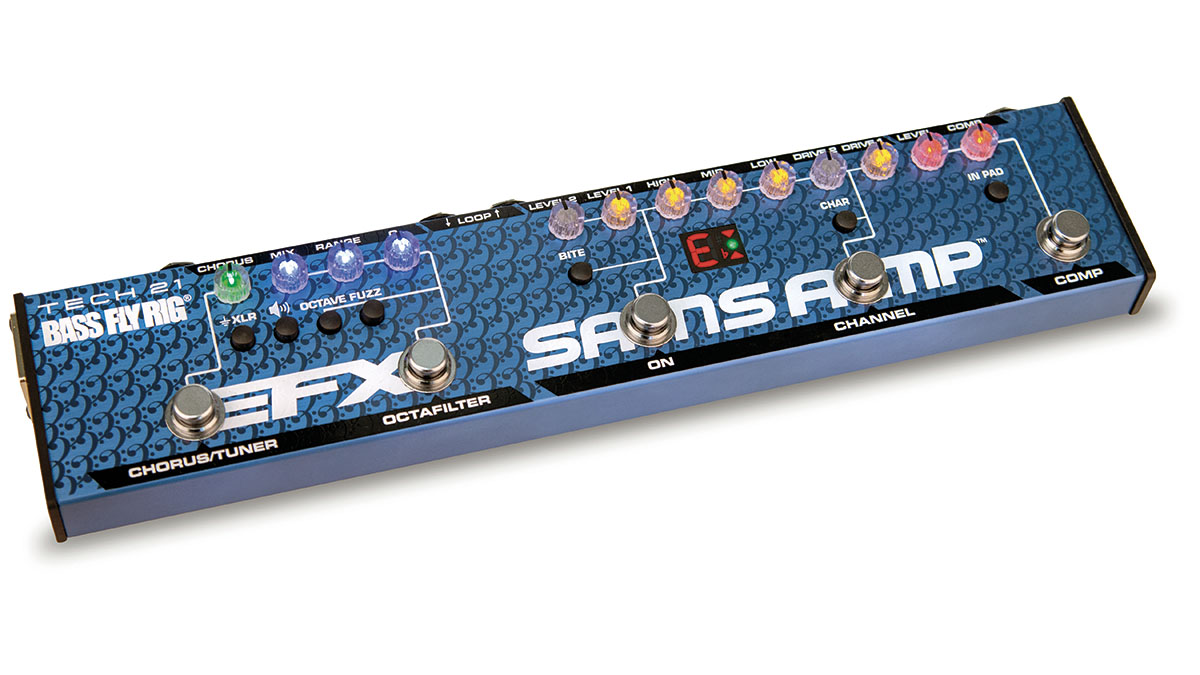Guitar World Verdict
It’s the SansAmp you can put in a bass case, packed with extra sounds – a splendid bit of kit.
Pros
- +
Solid build.
- +
Portable.
- +
Excellent tone options and extras.
Cons
- -
More affordable alternatives exist.
You can trust Guitar World
Tech 21’s groundbreaking SansAmp, the innovation of electronics whiz Andrew Barta, was first sold in 1989. Its core idea was and remains that it enables the user to emulate an amp and cab while requiring neither, instead sending a signal to a recording desk, a PA, or in modern times, a computer soundcard.
It’s been widely supported in our world, with varying models assigned to celebrity bassists, and a portable version, the Bass Fly Rig, which was first manufactured in 2014. This v2 version of the product offers bassists a few new options in addition to its primary function – to offer the SansAmp technology in a highly portable unit.
The idea of touring without an amp, as well as recording without one, is increasingly attractive in the era of aggressive airline staff and digital workstations, so this unit –only about a foot long and weighing around 12 ounces (350 grams), is doubly welcome.
As Tech 21 eloquently put it, “No crackling patch cables, dying batteries or ground loops... No dreading cheesy backline loaners and overheating at the mere thought of your touring rig going down.”

The Fly Rig comes in a metal box that appears strong enough for most purposes, and Tech 21 have wisely included a power supply with multiple plug adaptors for different continents. You might expect these details to be taken care of at the midmarket price of this unit, but you’d be surprised how often they’re ignored.
Running from right to left, or in to out if you prefer, the unit is split into four sections, with a compressor up front in the signal chain, then the SansAmp section itself, followed by an octaver and fuzz, and finally a chorus and tuner.
Each section is illuminated with a different color, the rotary controls themselves lighting up brightly, and there’s an effects loop and XLR out if required. While none of this sounds particularly complex, you’d be advised to check the manual before you plug in. I know you won’t, though, so have fun making weird noises before you come to your senses and take the advice provided for you.
All the latest guitar news, interviews, lessons, reviews, deals and more, direct to your inbox!

Plugging in, the first thing you come across is a pad button for active basses. If you’re in the habit of ignoring this option, as some of us do, take it seriously on this occasion, because the Bass Fly Rig’s controls are super-sensitive and you’ll max everything out very easily. If you do clip, by the way, the Chorus button lights up as a warning, which is a useful touch.
Once you’re in, you have two channels to choose from, one equipped with a Character button for extra presence; each channel has a three-band EQ, Level and Drive control which come to life when the SansAmp circuit is activated and provide you with the overdrive for which SansAmps are renowned.
As the helpful diagrams in the manual reveal, various combinations of drive and EQ will give you mildly crunchy tones, via full-on distortion, to the kind of ear-bleeding sonic maelstrom that will kill cows at 100 paces.
You can combine your overdriven tone with the octaver/fuzz controls if you’re brave and skilful enough. This requires some judgement if you want to avoid making your tone into chaotic sludge, but with the controls used carefully, it can be done. Lose the SansAmp component, though, and the combination of octave and fuzz – modulated with a Range control as a tone pot – will give you all sorts of slippery wah and filter options.
Finally, there’s a single-control chorus, which combines the usual depth and range controls pretty efficiently, and a simple-to-use tuner. You can also ‘defeat’ the cab simulation feature if you wish.
Despite all this chat about overdrive, there are plenty of clean tones available to you here, as the sample tones in the manual indicate. Take advantage of the Character switch, which offers a choice between SansAmp Bass Driver tones and VT Bass DI tones, both of which supply a range of familiar sounds.
The Bass Fly Rig is a solid chunk of metal, and is equipped with silent switching, a boon given all the controls. I’m very impressed with how well the signal chain is planned, and each option is effectively designed and laid out. Whether you’re new to the SansAmp concept or a newbie, you’ll enjoy its comprehensive functionality.
Specs
- PRICE: $299 / £355 (street price)
- MADE IN: USA
- FEATURES: Analogue SansAmp tube amp emulation circuitry (two modes), 2 x Drive controls, 2 x Level controls, Bite switch, active post-EQ (+/- 12dB), compressor, Octafi lter, Fuzz and Chorus controls, chromatic tuner, 0.25” 4.7megOhm input, input pad for active basses, XLR out, 0.25” low impedance out, speaker simulation defeat switch
- POWER: 9V DC power supply (included) with interchangeable international plugs
- DIMENSIONS: 12.5” (L) x 2.75” (W) x 1.3” (D) / 318mm x 70mm (W) x 30mm (D)
- WEIGHT: 12.5oz
- CONTACT: Tech 21
Joel McIver was the Editor of Bass Player magazine from 2018 to 2022, having spent six years before that editing Bass Guitar magazine. A journalist with 25 years' experience in the music field, he's also the author of 35 books, a couple of bestsellers among them. He regularly appears on podcasts, radio and TV.


